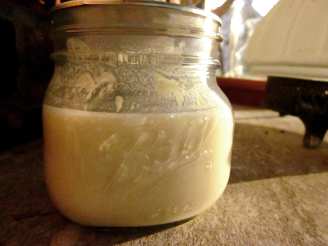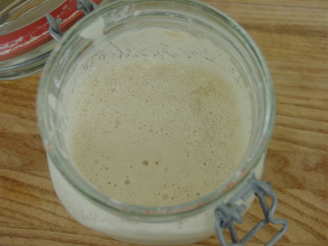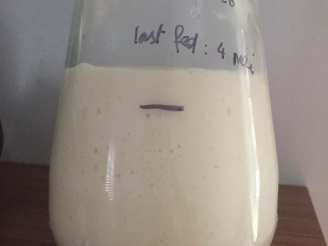Sourdough Starter

- Ready In:
- 672hrs 30mins
- Ingredients:
- 5
- Yields:
-
1 batch sourdough starter
ingredients
-
The Starter
- 1 bunch organic red grapes
- 500 g unbleached strong white bread flour
- 1 liter water
-
The Food
- 100 g unbleached strong white bread flour
- 150 ml water
directions
- Wash the grapes and wrap them in a muslin or fine cheese cloth.
- Loosely tie the open end with a string or elastic band and lightly crush the grapes inside with a rolling pin.
- Combine the flour and water in a large plastic, ceramic or stainless-steel bowl.
- It is best if you can find one with a lid.
- Squeeze some of the juice from the grapes into the flour and water mixture, before completely burying the little bag inside the mixture.
- Cover with the lid or a plate and leave for 10 days to two weeks at room temperature, around 20 C or 68 F.
- The grapes should start to ferment and the bag should balloon slightly with the gases being given off by the grapes.
- Pull the bag out of the mixture and squeeze any juice back into the white mixture.
- Throw away the grapes and the bag.
- Stir the starter, which should now be slightly pink and have a sour, grapey smell.
- Now you should pour away about a third of the initial starter mixture and stir in one batch of its food.
- In the beginning, you will have to feed your starter twice a day (best done at regular intervals) for two weeks.
- Just before you feed the starter, make sure you also throw away 200ml of the basic mixture.
- This might seem like a waste but if you don't you will have far too much starter!
- After two weeks, your starter should really be alive and kicking.
- Taste a bit and it should have a slight fizz to it.
- If the starter doesn't taste fizzy, keep feeding it until it does.
- A slightly lower room termperature can slow things up a bit.
- When it tastes fizzy you are ready to start making bread.
- To keep your starter going (it is a living thing, after all) you should only need to feed it once a week and leave it in the fridge, unless you are making bread more than once a week.
- If you are not making bread very often, you can leave feedings for two weeks.
- Make sure you keep it in the fridge, which slows the starter down.
- If it is kept at room temperature, it will need to be fed every day.
- Between making bread, give the starter at least a day to recover.
Questions & Replies
Got a question?
Share it with the community!
Reviews
Have any thoughts about this recipe?
Share it with the community!
RECIPE SUBMITTED BY
This is a picture of me and my husband in Portugal, climbing up above the clouds with our bikes.
Right now we are travelling around the world on our bicycles, so I only pop onto Zaar occasionally, when internet connections and time allow me to. If I don't reply to a message about one of my recipes, now you know why! Our trip may take several years so if it's urgent, it's probably better for you to post in the forums ;)
Good food is really important to me -- I am happy to pay extra for food that I feel is produced in a sustainable and ethical way and always try to eat using seasonal produce.
When we were in the UK we rarely shopped at supermarkets, trying instead to favour small producers, although we were very lucky in that we lived in London and there was lots of choice.
We also were fortunate enough to have a weekly organic veg box delivered to our door, filled with so many lovely vegetables for very little money. It really opened my horizons in terms of the variety of vegetables I eat. If you're in the UK, check out Riverford for a box supplier as they're amazing!
When I'm not eating I love to take pictures and travel with my husband.
<img src="http://i3.photobucket.com/albums/y53/DUCHESS13/World%20Tour/ZWT2.gif">




